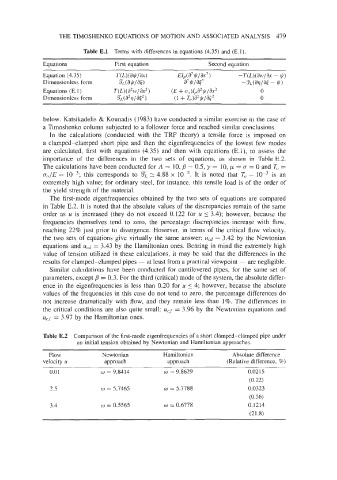Page 509 - Fluid-Structure Interactions Slender Structure and Axial Flow (Volume 1)
P. 509
THE TIMOSHENKO EQUATIONS OF MOTION AND ASSOCIATED ANALYSIS 479
Table E.l Terms with differences in equations (4.35) and (E.1).
~
Equations First equation Second equation
below. Katsikadelis & Kounadis (1983) have conducted a similar exercise in the case of
a Timoshenko column subjected to a follower force and reached similar conclusions.
In the calculations (conducted with the TRF theory) a tensile force is imposed on
a clamped-clamped short pipe and then the eigenfrequencies of the lowest few modes
are calculated, first with equations (4.35) and then with equations (E.l), to assess the
importance of the differences in the two sets of equations, as shown in Table E.2.
The calculations have been conducted for A = 10.6 = 0.5, y = 10, p = o = 0 and T, =
a,/E = this corresponds to 9~ 4.88 x lop2. It is noted that To = lop3 is an
2:
extremely high value; for ordinary steel, for instance, this tensile load is of the order of
the yield strength of the material.
The first-mode eigenfrequencies obtained by the two sets of equations are compared
in Table E.2. It is noted that the absolute values of the discrepancies remain of the same
order as u is increased (they do not exceed 0.122 for u 5 3.4); however, because the
frequencies themselves tend to zero, the percentage discrepancies increase with flow,
reaching 22% just prior to divergence. However, in terms of the critical flow velocity,
the two sets of equations give virtually the same answer: Urd = 3.42 by the Newtonian
equations and u,d = 3.43 by the Hamiltonian ones. Bearing in mind the extremely high
value of tension utilized in these calculations, it may be said that the differences in the
results for clamped-clamped pipes - at least from a practical viewpoint - are negligible.
Similar calculations have been conducted for cantilevered pipes, for the same set of
parameters, except 6 = 0.3. For the third (critical) mode of the system, the absolute differ-
ence in the eigenfrequencies is less than 0.20 for u I 4; however, because the absolute
values of the frequencies in this case do not tend to zero, the percentage differences do
not increase dramatically with flow, and they remain less than 1%. The differences in
the critical conditions are also quite small: ucf = 3.96 by the Newtonian equations and
urj = 3.97 by the Hamiltonian ones.
Table E.2 Comparison of the first-mode eigenfrequencies of a short clamped-clamped pipe under
an initial tension obtained by Newtonian and Hamiltonian approaches.
Flow Newtonian Hamiltonian Absolute difference
velocity u approach approach (Relative difference, %)
0.01 w = 9.8414 w = 9.8629 0.02 15
(0.22)
2.5 w = 5.7465 w = 5.7788 0.0323
(0.56)
3.4 w = 0.5565 w = 0.6778 0.1214
(21.8)

